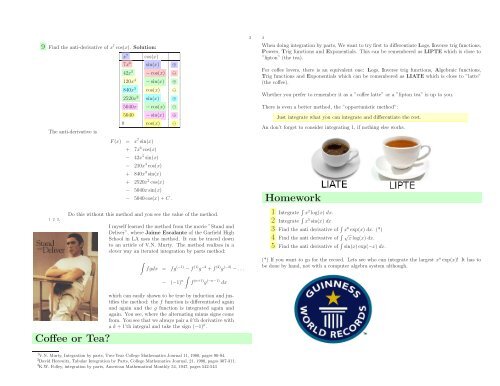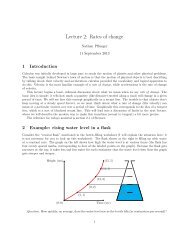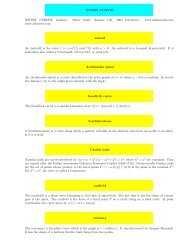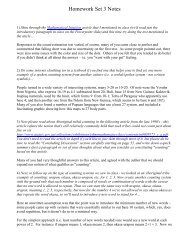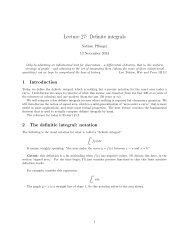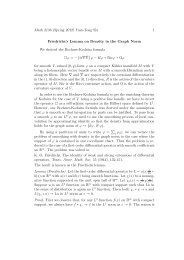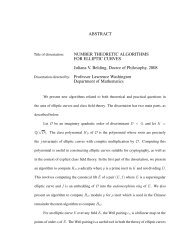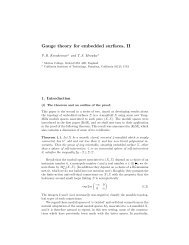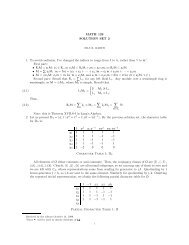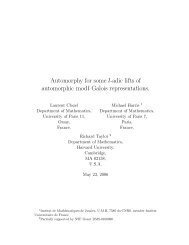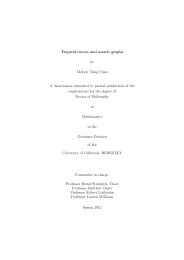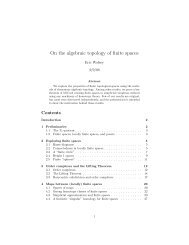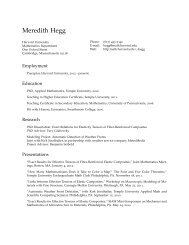Lecture 29: Integration by parts Tic-Tac-Toe
Lecture 29: Integration by parts Tic-Tac-Toe
Lecture 29: Integration by parts Tic-Tac-Toe
Create successful ePaper yourself
Turn your PDF publications into a flip-book with our unique Google optimized e-Paper software.
9 Find the anti-derivative of x 7 cos(x). Solution:<br />
The anti-derivative is<br />
1 2 3 :<br />
x 7 cos(x)<br />
7x 6 sin(x) ⊕<br />
42x 5 −cos(x) ⊖<br />
120x 4 −sin(x) ⊕<br />
840x 3 cos(x) ⊖<br />
2520x 2 sin(x) ⊕<br />
5040x −cos(x) ⊖<br />
5040 −sin(x) ⊕<br />
0 cos(x) ⊖<br />
F(x) = x 7 sin(x)<br />
+ 7x 6 cos(x)<br />
− 42x 5 sin(x)<br />
− 210x 4 cos(x)<br />
+ 840x 3 sin(x)<br />
+ 2520x 2 cos(x)<br />
− 5040xsin(x)<br />
− 5040cos(x)+C .<br />
Do this without this method and you see the value of the method.<br />
I myself learned the method from the movie ”Stand and<br />
Deliver”, where Jaime Escalante of the Garfield High<br />
School in LA uses the method. It can be traced down<br />
to an article of V.N. Murty. The method realizes in a<br />
clever way an iterated integration <strong>by</strong> <strong>parts</strong> method:<br />
<br />
fgdx = fg (−1) −f (1) g −2 +f (2) g (−3) −...<br />
− (−1) n<br />
<br />
f (n+1) g (−n−1) dx<br />
which can easily shown to be true <strong>by</strong> induction and justifies<br />
the method: the f function is differentiated again<br />
and again and the g function is integrated again and<br />
again. You see, where the alternating minus signs come<br />
from. You see that we always pair a k’th derivative with<br />
a k +1’th integral and take the sign (−1) k .<br />
Coffee or Tea?<br />
1 V.N. Murty, <strong>Integration</strong> <strong>by</strong> <strong>parts</strong>, Two-Year College Mathematics Journal 11, 1980, pages 90-94.<br />
2 David Horowitz, Tabular <strong>Integration</strong> <strong>by</strong> Parts, College Mathematics Journal, 21, 1990, pages 307-311.<br />
3 K.W. Folley, integration <strong>by</strong> <strong>parts</strong>, American Mathematical Monthly 54, 1947, pages 542-543<br />
3<br />
4<br />
When doing integration <strong>by</strong> <strong>parts</strong>, We want to try first to differentiate Logs, Inverse trig functions,<br />
Powers, Trig functions and Exponentials. This can be remembered as LIPTE which is close to<br />
”lipton” (the tea).<br />
For coffee lovers, there is an equivalent one: Logs, Inverse trig functions, Algebraic functions,<br />
Trig functions and Exponentials which can be remembered as LIATE which is close to ”latte”<br />
(the coffee).<br />
Whether you prefer to remember it as a ”coffee latte” or a ”lipton tea” is up to you.<br />
There is even a better method, the ”opportunistic method”:<br />
Just integrate what you can integrate and differentiate the rest.<br />
An don’t forget to consider integrating 1, if nothing else works.<br />
Homework<br />
1 Integrate x 2 log(x) dx.<br />
2 Integrate x 5 sin(x) dx<br />
3 Find the anti derivative of x 6 exp(x) dx. (*)<br />
4 Find the anti derivative of √ xlog(x) dx.<br />
5 Find the anti derivative of sin(x)exp(−x) dx.<br />
(*) If you want to go for the record. Lets see who can integrate the largest x n exp(x)! It has to<br />
be done <strong>by</strong> hand, not with a computer algebra system although.


